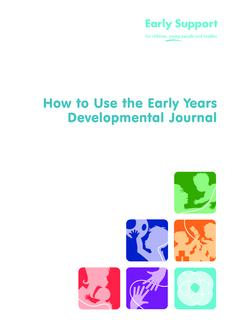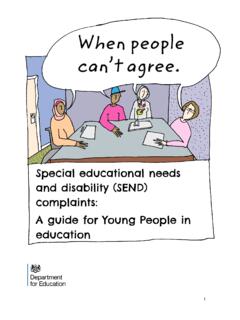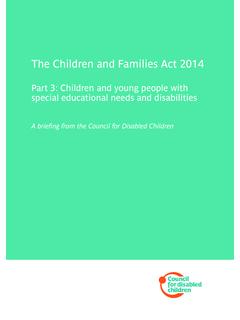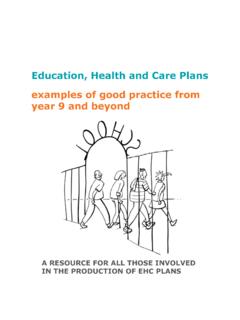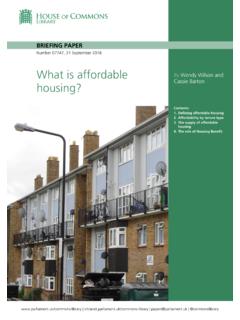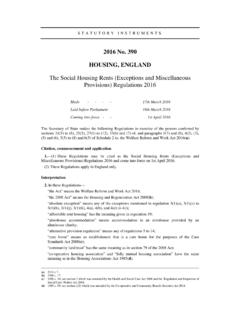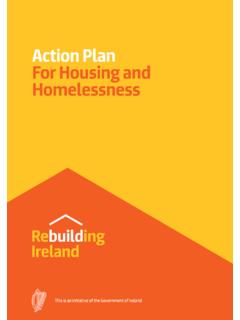Transcription of Chapter 6
1 HousingChapter 6 Responsibilities of housing authorities and duties to Families with disabled children becoming homeless housing adaptations disabled facilities Statutory Grant-eligible works Facilitating access Making the home safe Room usable for sleeping Bathroom Fixtures and Individual eligibility for DFGs Main residence Tenure Occupancy Decisions on individual Maximum Means Timescales and grant Discretionary Appropriate housing is a foundation of the right to an ordinary life for disabled children. As with many areas covered in this book, disabled children have the First published in Broach, Clements and Read, Disabled children: a legal handbook, Legal Action Group 2010.
2 Available at This downloadable material is copyright basic housing needs as their non-disabled peers. However, many disabled children also require adaptations to their homes to make them safe and reasonably accessible for them to live in. For some disabled children, for instance those with autism or who use bulky equipment, the need may simply be for more space than would be considered necessary for a non-disabled child. The practice guidance to the Children Act (CA) 1989 notes that when houses are well adapted for a particular child, the family s life can be transformed .1 Yet as has been noted in Chapter 1 (para above), many families with disabled children currently live in housing which is restrictive and unsuitable for both the child or children and their carers.
3 These families also frequently suffer from a chronic lack of space or live in housing which is simply sub-standard. This Chapter does not attempt to set out all the duties owed to children and families under the housing Act 1996 and related legislation. Not only would this be impossible given the limited space, but also a number of other excellent handbooks can provide this This Chapter instead focuses on the links between housing rights and duties and those rights and duties created by the community care scheme. housing duties are owed by housing authorities, which will be part of the same (unitary) local authority as a children s services authority in some areas but in other areas will be a different authority; the housing authority will be the district council whereas the social services authority will be the county council.
4 The particular focus of this Chapter is on the duty to make adaptations to the home of a disabled child through a disabled facilities grant (DFG).3 The Chapter also looks specifically at the ways in which families with disabled children can qualify for assistance as homeless if their accommodation is seriously unsuitable for their child s needs. The provision of accommodation under the Children Act 1989 to homeless children (section 20) is dealt with in Chapter of housing authorities and duties to In meeting their responsibilities to consider housing conditions and provision in their area, housing authorities are obliged under the Chronically Sick and Disabled Persons Act (CSDPA) 1970 s34 to have specific regard to the needs of disabled people, including disabled children.
5 This duty is exemplified in practice guidance issued in England in 20065 which calls for the social inclusion of all citizens and requires housing authorities to counter disabling environments through planning and housing design. When deciding who would have priority for public housing in their area (known as an allocations scheme ), local authorities must give reasonable preference to individuals (including disabled children) who need to move on medical or welfare When a family has had their has had their priority within their council s allocations scheme assessed7 this becomes a material consideration in relation to any future community care assessment,8 which would include a Children Act initial or core assessment (see para ).
6 There is an obvious requirement on housing authorities and children s services authorities to co-operate to ensure that the housing needs of disabled children are met. This longstanding duty is presently to be found in Children Act 2004 s10 and housing Act 1996 s213. In relation to this obligation, joint guidance issued by the then-Departments of Health and the Environment in 1992,9 which is still in force, states (at [16]) that:Social services authorities and housing should construct an individual s care plan with the objective of preserving or restoring non-institutional living as far as possible, and of securing the most appropriate and cost-effective package of care, housing and other services that meets the person s future needs.
7 Under section 3 of the Homelessness Act 2002, housing authorities must have a homelessness strategy which seeks to prevent homelessness, including arrangements for satisfactory provision of support for people at risk of homelessness. The Homelessness Code of Guidance10 stresses the importance of social services authorities, including children s services authorities, working together to develop this strategy and prevent homelessness for specific groups, which would include families with disabled Examples of collaborative working are listed at of the Homelessness Code and include joint protocols for referral of clients between agencies a matter recently stressed as critical by Baroness Hale in relation to homeless teenagers in R (G) v Southwark LBC12 (see para ).
8 Duties to co-operate with housing authorities also extend to health bodies: as we note above (see paras ) NHS Act 2006 s82 places an obligation on NHS bodies and local authorities to co-operate with one another in order to secure and advance the health and welfare of the people of England and Wales . Although this longstanding duty has been stressed in many policy documents,13 the evidence suggests that its operation leaves much to be desired. By way of example, in 2008 the ombudsman criticised as appalling the failure of Kirklees MBC to make suitable adaptations to the home of a quadriplegic young man following his discharge from hospital, with the result that he was confined to two unsuitable rooms without suitable facilities for washing for over 18 Families with disabled children becoming homeless Families with disabled children can come within the provisions of Part VII of the housing Act 1996, which governs support for homeless people.
9 In essence a housing authority is required to provide accommodation under these provisions if satisfied on four issues, namely: (1) that the person/family is homeless or threatened with homelessness; (2) that the person or a member of the family is vulnerable and so in priority need; (3) that the person/family has a local connection with the council; and (4) that the person/family is not intentionally Under section 175(3) of the 1996 Act, a person is considered to be homeless, not only if they lack a roof, but also if they have accommodation which for one reason or another it is not reasonable for them to live in. Furthermore, a family with a disabled child will be in priority need for the purposes of Part VII and therefore will potentially qualify for homelessness assistance.
10 See section 189(1)(c) of the 1996 The duties under the homelessness scheme to families with disabled family members were considered in detail in Birmingham CC v Ali and Baroness Hale, with whom the other Law Lords agreed, stressed that where a family are homeless as a result of their accommodation being unsuitable, a housing authority may have an immediate duty to transfer the family to suitable The case concerned a number of large families who were unsuitably housed in accommodation that was seriously Baroness Hale paid particular attention to the fact that under section 175(3) of the 1966 Act (as above):A person shall not be treated as having accommodation unless it is accommodation which it would be reasonable for him to continue to In the court s opinion the duty under section 175(3) was a prospective and ongoing duty, ie one that had to be considered at all stages and kept under If a family is homeless, eligible for assistance and has a priority need, then a housing authority is under an interim duty to secure suitable accommodation for the family pending a final decision on entitlement (HA 1996 s188(1)).
